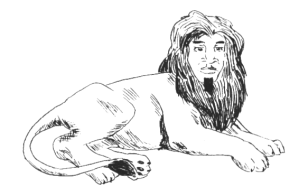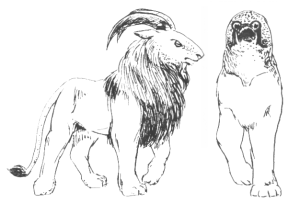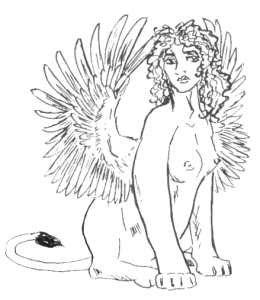The sphinx is a leonine creature with the head of a ram, hawk, or human.
While similar creatures appear in many different cultures, the sphinx is native to ancient Egypt. There are three subspecies, each with a different head structure. The criosphinx features the head of a ram; the heiracosphinx has the head of a hawk; and the androsphinx has the more familiar human head. The sphinx is a guardian creature, most commonly seen as protector of sacred areas. The various head structures signify the deity with which it is most strongly associated. The criosphinx can be found in great numbers near the temple of Amon, and androsphinxes often bear a curious resemblance to the pharaohs whose tombs and temples they guard. They are also associated with the sun. An ancient creature, the sphinx predates most other apparently “hybridized” beasts from the area.
A second species of sphinx, or “phix” is known in ancient Greece. It is found in Thebes, although it is thought to originate from AEtheopia. Like its Egyptian cousin, it also has a lion’s body. It has the head and bust of a human woman. Some older versions are reputed to have a snake or dragon tail, sometimes even said to have a snake’s head at the end. A variation of the creature sports feathered wings, although it is not capable of powered flight. Like the Egyptian sphinx, this creature is sometimes found in a guardian role, and can sometimes also be seen near tombs and temples. The Greek sphinx is highly aggressive and known to kill and eat unwary travelers. It is also intelligent, and it is known to be able to hold conversations with humans, most notably posing riddles for potential victims. They can be high strung and do not respond well to being bested in a battle of wits, sometimes leading to self-harm or even suicide.
While the striking appearance of this creature make it instantly recognizable, hardly any stories of it survive. This makes examination of common behaviors, territories, and other information difficult. Both the Egyptian and Greek sphinxes are thought to be connected to older, less familiar traditions. Contact with other cultures brought many changes to the creature, rendering it symbolic of the sun, knowledge, strength, and even Jesus. It was also retroactively associated it with other creatures such as the Assyrian Lamassu.
Today, the best known is the Great Sphinx of Giza, also called “Sesheps,” a 260 foot long statue. Other well-known sphinxes include the alabaster sphinx of Memphis; the nine-hundred criosphinxes of Thebes; and the sphinx of Queen Hetapheres II, possibly the first of her kind. Greek art has many examples of the sphinx, often paired with a lion, gryphon, or second sphinx. In modern culture, the sphinx appears as both a monster and a keeper of knowledge. A pair of Greek sphinxes are seen in both the novel and the film The Neverending Story. While both versions use a Sphinxes appear novels Harry Potter and the Goblet of Fire by J. K. Rowling, Pyramids by Terry Pratchett, and the Xanth series by Piers Anthony. A 2003 video game called Sphinx and the Cursed Mummy features a character based upon the Great Sphinx as the player character.
Further reading:
Encyclopedia Britanica
Theoi Greek Mythology
New World Encyclopedia
King Tut One





